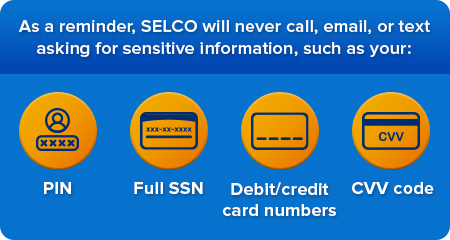 Your trip of a lifetime is almost here.
Your trip of a lifetime is almost here.
Your passport is up to date and ready for some new stamps. You know what you need to pack—and how to make use of every square inch of luggage. You’ve learned about the culture and all the exotic food at your destination. You’re ready to travel across the international dateline.
But are you financially ready? You’ve meticulously saved for this vacation, but minding your finances doesn’t stop there.
Protect your accounts
Bad actors are always waiting to pounce. Make sure they can’t get anywhere near your accounts by taking a few extra precautions. We highly recommend that you do the following in digital banking before traveling:
- Add login security validation.
- Enable face/fingerprint ID.

Secure your cards
Don’t take a vacation from monitoring your cards. In fact, you’ll want to be extra diligent while using your cards in different ways at different places. Besides taking account security measures in digital banking, you’ll also want to set the following for your cards:
- Travel notices. Filing a travel notice through digital banking may reduce the possibility of declines on your credit or debit card.
- Card alerts. Receive notifications when certain transactions are made or if your card is declined.
- Card controls. Set transaction limits, allow/prevent transaction and merchant types, or even turn your cards off when you’re not using them.
If you have a SELCO Platinum Visa® or SELCO Visa Debit Card, you also benefit from Visa's Zero Liability Policy, a guarantee that you won’t be held responsible for unauthorized charges made with your account. Once an unauthorized transaction is reported, the issue will be resolved, and funds replaced in your account, within 10 business days. Even if no unauthorized transactions are reported, if Visa detects a transaction out of the ordinary, your card may still get flagged.
Take multiple forms of payment
While traveling internationally, you might be tempted to use your credit card everywhere you go. But it’s a better idea to mix your payment methods to throw would-be fraudsters off your scent.
- Consider using a credit card for meals, lodging, or other larger purchases.
- Try to avoid using a debit card for anything but withdrawing cash overseas. Debit cards come with fewer consumer rights, and continual purchases can quickly drain your checking or savings account. Keep in mind that there will be a 1% fee for each international transaction with your SELCO credit and debit cards. Local ATMs may also charge a one-time fee.
- Mobile wallets like Apple Pay and Google Pay are another safe, convenient option. Pickpockets are lurking around every corner, so consider putting your phone and wallet in your front pockets or wear a crossbody purse or pack across your chest.
Exchange your cash
There are numerous ways to convert US dollars to international currency before you take off or after you land.
Before embarking on your journey, check exchange rates and the best places to exchange currency. AAA offers foreign-currency purchases for a minimal fee. But keep in mind: There are no buybacks when you return; you’ll need to spend it all. Often, your best bet is to withdraw only what you know you’ll spend. Avoid taking out a cash advance with your credit card, however. You’ll get hit with a cash-advance fee and a high interest rate that begins accruing immediately.
Arm yourself with these tips and precautions so you can have an exciting and worry-free adventure abroad. And don’t hesitate to contact us for additional tips or help getting prepared.


